译林版小学英语2B u2教案
- 格式:docx
- 大小:24.07 KB
- 文档页数:8
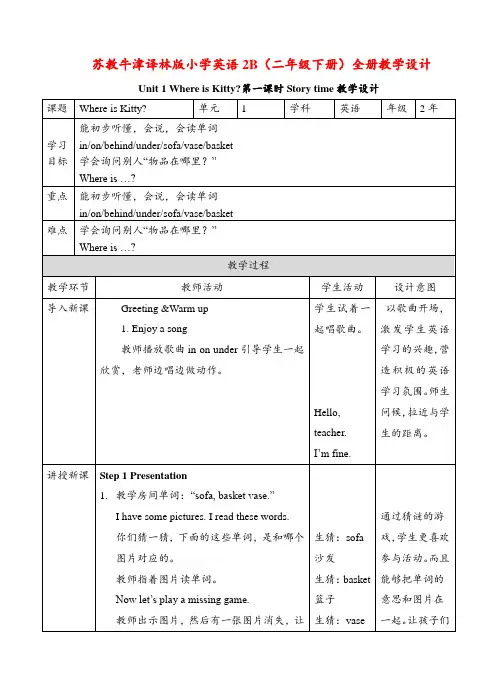
苏教牛津译林版小学英语2B(二年级下册)全册教学设计Unit 1 Where is Kitty?第一课时Story time教学设计Unit 1 Where is Kitty?第二课时Fun time 教学设计课题Where is Kitty? 单元 1 学科英语年级2年学习目标能初步听懂,会说,会读单词in/on/behind/under/sofa/vase/basket学会询问别人“物品在哪里?”Where is …? It’s on /in/under/behind…生答:It’s inthe kitchen.生答:They’re inthe tree.生猜说出句子。
课堂小结学会介词in/on/behind/under学会询问别人“物品在哪里?”Where is …?板书Unit 1 Where is Kitty?in underon behindUnit 1 Where is Kitty?第三课时Rhyme time 教学设计课题 Where is Kitty? 单元1学科英语年级 2年学习 目标 通过学习歌曲Molly the cat.,学会重点句子:It’s in the living room.It’s on the mat.It’s playing with a broom.乐于唱歌,激发对英语的兴趣。
重点 学会重点句子:It’s in the living room.It’s on the mat.It’s playing with a broom.难点 会唱歌曲Molly the cat.1. Where is the monkey?2. Where is the ball?3. Where is the rabbit?4. Where is the bird?5. Where is the dog?sofa. It’s on the floor. It’s on the chair. It’s on the light. It’s under the table. It’s under the table.课堂小结 板书Unit 1 Where is Kitty?W Where is the monkey?It’s on the sofa. Where is the monkey? It’s behind the sofa.Unit 2 Dinner is ready.第一课时Story time教学设计Unit 2 Dinner is ready.第二课时fun time教学设计小猫来了。
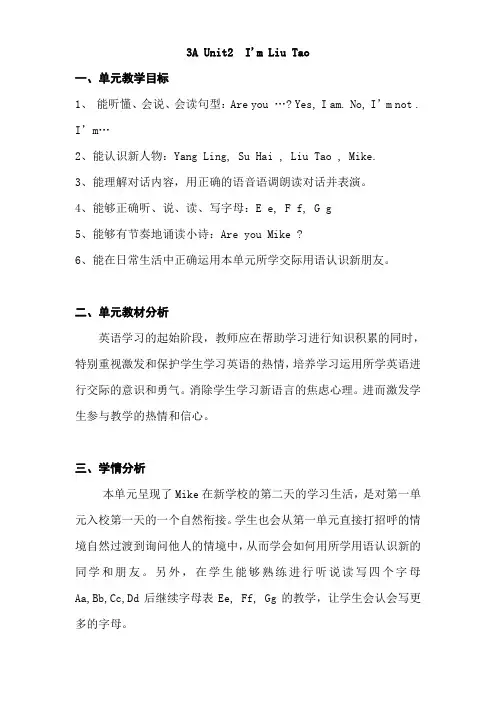
3A Unit2 I'm Liu Tao
一、单元教学目标
1、能听懂、会说、会读句型:Are you …? Yes, I am. No, I’m not . I’m…
2、能认识新人物:Yang Ling, Su Hai , Liu Tao , Mike.
3、能理解对话内容,用正确的语音语调朗读对话并表演。
4、能够正确听、说、读、写字母:E e, F f, G g
5、能够有节奏地诵读小诗:Are you Mike ?
6、能在日常生活中正确运用本单元所学交际用语认识新朋友。
二、单元教材分析
英语学习的起始阶段,教师应在帮助学习进行知识积累的同时,特别重视激发和保护学生学习英语的热情,培养学习运用所学英语进行交际的意识和勇气。
消除学生学习新语言的焦虑心理。
进而激发学生参与教学的热情和信心。
三、学情分析
本单元呈现了Mike在新学校的第二天的学习生活,是对第一单元入校第一天的一个自然衔接。
学生也会从第一单元直接打招呼的情境自然过渡到询问他人的情境中,从而学会如何用所学用语认识新的同学和朋友。
另外,在学生能够熟练进行听说读写四个字母Aa,Bb,Cc,Dd后继续字母表Ee, Ff, Gg的教学,让学生会认会写更多的字母。
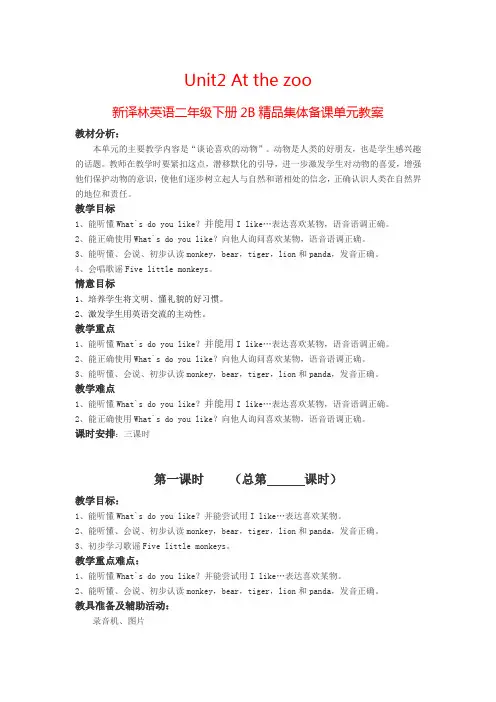
Unit2 At the zoo新译林英语二年级下册2B精品集体备课单元教案教材分析:本单元的主要教学内容是“谈论喜欢的动物”。
动物是人类的好朋友,也是学生感兴趣的话题。
教师在教学时要紧扣这点,潜移默化的引导,进一步激发学生对动物的喜爱,增强他们保护动物的意识,使他们逐步树立起人与自然和谐相处的信念,正确认识人类在自然界的地位和责任。
教学目标1、能听懂What`s do you like?并能用I like…表达喜欢某物,语音语调正确。
2、能正确使用What`s do you like?向他人询问喜欢某物,语音语调正确。
3、能听懂、会说、初步认读monkey,bear,tiger,lion和panda,发音正确。
4、会唱歌谣Five little monkeys。
情意目标1、培养学生将文明、懂礼貌的好习惯。
2、激发学生用英语交流的主动性。
教学重点1、能听懂What`s do you like?并能用I like…表达喜欢某物,语音语调正确。
2、能正确使用What`s do you like?向他人询问喜欢某物,语音语调正确。
3、能听懂、会说、初步认读monkey,bear,tiger,lion和panda,发音正确。
教学难点1、能听懂What`s do you like?并能用I like…表达喜欢某物,语音语调正确。
2、能正确使用What`s do you like?向他人询问喜欢某物,语音语调正确。
课时安排:三课时第一课时(总第课时)教学目标:1、能听懂What`s do you like?并能尝试用I like…表达喜欢某物。
2、能听懂、会说、初步认读monkey,bear,tiger,lion和panda,发音正确。
3、初步学习歌谣Five little monkeys。
教学重点难点:1、能听懂What`s do you like?并能尝试用I like…表达喜欢某物。
2、能听懂、会说、初步认读monkey,bear,tiger,lion和panda,发音正确。
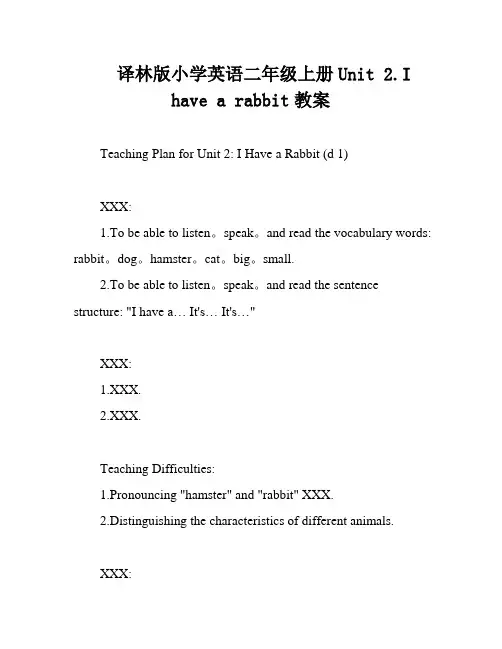
译林版小学英语二年级上册Unit 2.Ihave a rabbit教案Teaching Plan for Unit 2: I Have a Rabbit (d 1)XXX:1.To be able to listen。
speak。
and read the vocabulary words: rabbit。
dog。
hamster。
cat。
big。
small.2.To be able to listen。
speak。
and read the sentence structure: "I have a… It's… It's…"XXX:1.XXX.2.XXX.Teaching Difficulties:1.Pronouncing "hamster" and "rabbit" XXX.2.Distinguishing the characteristics of different animals.XXX:n:1.Free talk: Greet the students and ask them how they are doing.2.Enjoy a song: Sing the song "This is My Uncle."3.Lead-in: Play a game called "Magic Ears" where students listen and guess the name of different animals。
Teach the words for "dog," "cat," and "hamster."Step 1: Look and SayShow pictures of a hamster and a dog and say。
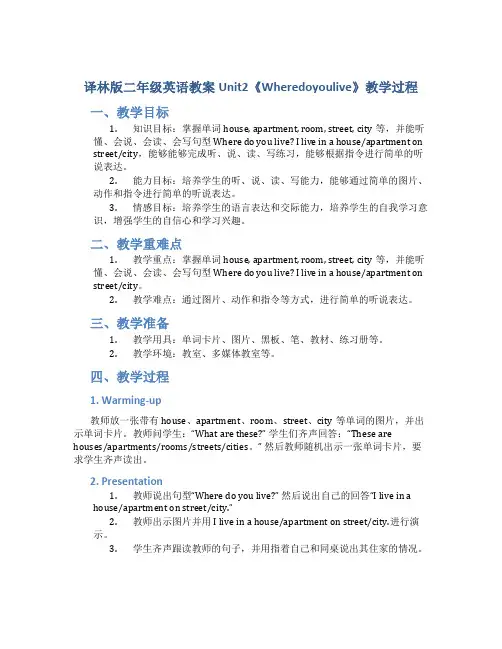
译林版二年级英语教案Unit2《Wheredoyoulive》教学过程一、教学目标1.知识目标:掌握单词house, apartment, room, street, city等,并能听懂、会说、会读、会写句型Where do you live? I live in a house/apartment on street/city,能够能够完成听、说、读、写练习,能够根据指令进行简单的听说表达。
2.能力目标:培养学生的听、说、读、写能力,能够通过简单的图片、动作和指令进行简单的听说表达。
3.情感目标:培养学生的语言表达和交际能力,培养学生的自我学习意识,增强学生的自信心和学习兴趣。
二、教学重难点1.教学重点:掌握单词house, apartment, room, street, city等,并能听懂、会说、会读、会写句型Where do you live? I live in a house/apartment on street/city。
2.教学难点:通过图片、动作和指令等方式,进行简单的听说表达。
三、教学准备1.教学用具:单词卡片、图片、黑板、笔、教材、练习册等。
2.教学环境:教室、多媒体教室等。
四、教学过程1. Warming-up教师放一张带有house、apartment、room、street、city等单词的图片,并出示单词卡片。
教师问学生:“What are these?” 学生们齐声回答:“These are houses/apartments/rooms/streets/cities。
” 然后教师随机出示一张单词卡片,要求学生齐声读出。
2. Presentation1.教师说出句型“Where do you live?” 然后说出自己的回答“I live in ahou se/apartment on street/city.”2.教师出示图片并用I live in a house/apartment on street/city.进行演示。
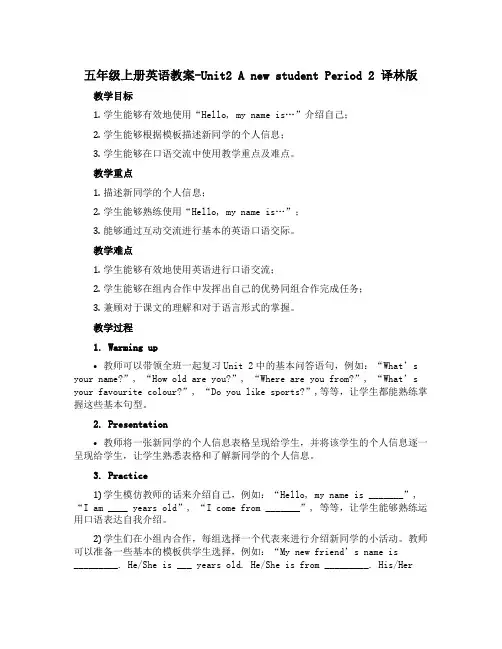
五年级上册英语教案-Unit2 A new student Period 2 译林版教学目标1.学生能够有效地使用“Hello, my name is…”介绍自己;2.学生能够根据模板描述新同学的个人信息;3.学生能够在口语交流中使用教学重点及难点。
教学重点1.描述新同学的个人信息;2.学生能够熟练使用“Hello, my name is…”;3.能够通过互动交流进行基本的英语口语交际。
教学难点1.学生能够有效地使用英语进行口语交流;2.学生能够在组内合作中发挥出自己的优势同组合作完成任务;3.兼顾对于课文的理解和对于语言形式的掌握。
教学过程1. Warming up•教师可以带领全班一起复习Unit 2中的基本问答语句,例如:“What’s your name?”, “How old are you?”, “Where are you from?”, “What’s your favourite colour?”, “Do you like sports?”,等等,让学生都能熟练掌握这些基本句型。
2. Presentation•教师将一张新同学的个人信息表格呈现给学生,并将该学生的个人信息逐一呈现给学生,让学生熟悉表格和了解新同学的个人信息。
3. Practice1)学生模仿教师的话来介绍自己,例如:“Hello, my name is _______”, “I am ____ years old”, “I come from _______”, 等等,让学生能够熟练运用口语表达自我介绍。
2)学生们在小组内合作,每组选择一个代表来进行介绍新同学的小活动。
教师可以准备一些基本的模板供学生选择,例如:“My new friend’s n ame is_________. He/She is ___ years old. He/She is from _________. His/Herfavourite colour is ________.” 学生在小组内扮演不同角色,通过互动来熟悉新同学的个人信息。
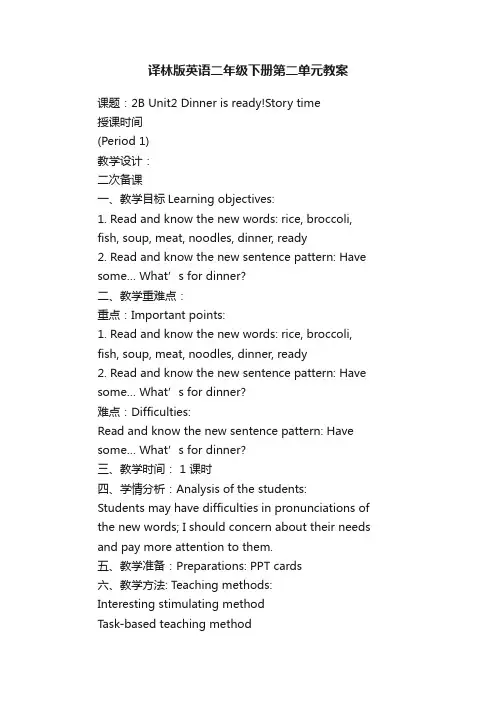
译林版英语二年级下册第二单元教案课题:2B Unit2 Dinner is ready!Story time授课时间(Period 1)教学设计:二次备课一、教学目标Learning objectives:1. Read and know the new words: rice, broccoli, fish, soup, meat, noodles, dinner, ready2. Read and know the new sentence pattern: Have some… What’s for dinner?二、教学重难点:重点:Important points:1. Read and know the new words: rice, broccoli, fish, soup, meat, noodles, dinner, ready2. Read and know the new sentence pattern: Have so me… What’s for dinner?难点:Difficulties:Read and know the new sentence pattern: Have some… What’s for dinner?三、教学时间: 1 课时四、学情分析:Analysis of the students: Students may have difficulties in pronunciations of the new words; I should concern about their needs and pay more attention to them.五、教学准备:Preparations: PPT cards六、教学方法: Teaching methods:Interesting stimulating methodTask-based teaching method七、教学过程:T eaching procedures:Step 1. Warming up1.Greetings.T:Good morning, boys and girls.Ss:Good morning, Miss Lu.T: Let’s say the chant: Molly the catStep 2. Presentation(1)1.Show a picture of a big mealT: Look, what yummy food do you like?Ss: sandwich, hot dog, hamburger…2.Look and say:①Today, we’ll learn some new food names.First we’ll have so me riddles.T: Guess: it is white. We eat it every day.What is it?S: Rice Teach: rice(Use different ways todrill)②T: Guess: it is long. We eat it on our birthday. What is it?S: noodles Teach: noodles(Use different ways to drill) ③Pair work: A: Have some…B: Thank you.④T: Guess: it is green. It’s a vegetable. S: broccoli Teach: broccoli(Use different ways to drill)⑤Use the similar way to teach: fish soup meat (Use different ways to drill)Step3. Presentation(2)Story time1.Watch and answer: What’s for dinner?2.Read and answer:①Who likes fish?②What does dad say in Picture 3?③What does Yang ling say in Picture 4? Teach: What’s for dinner?Have some…(Use different ways to drill)3. Listen and imitateRead together/ in groups/ in pairs.4.Act it outStep4. Consolidation1. Magic eyesTo review the new words and sentences.2. Introduce yummy food.A: What’s for dinner?B: … and…A: Have some…B: Thank you.3. Let’s talk八、作业设计:Homework:1. Read Story time after the tape2. Copy and recite the new words九、板书设计Unit 2 Dinner is ready!Have some… What’s for dinner?rice, broccoli, fish, soup, meat, noodles, dinner,教学评价:课题:2B Unit2 Dinner is ready!Fun time授课时间(Period 2)二次备课教学设计:一、教学目标Learning objectives:1. Understand and use the key words: rice, broccoli, fish, soup, meat, noodles, dinner, ready2. Understand and use the sentence pattern: Have some… What’s for dinner?3. Apply the sentence patterns to similar situations.二、教学重难点:重点:Important points:Ss can understand and use the key words: rice, broccoli, fish, soup, meat, noodles, dinner, ready Ss can understand and use the sentence pattern: Have some… What’s for dinner?难点:Difficulties:Ss can apply the sentence patterns to similar situations.三、教学时间: 1 课时四、学情分析:Analysis of the students:Some students may have difficulties in sentence patterns, the teacher need to focus on the key points and create more real situations for students to practice.五、教学准备:Preparations: PPT, cards六、教学方法: Teaching methods:Situational teaching methodTask-based teaching method七、教学过程:T eaching procedures:Step1 Warming up:T: Class begins.Ss: Stand up.T: Good morning, boys and girls.Ss: Good morning, Miss Lu.T: Sit down, please.Enjoy the song: on in underStep2 Revision:1. Magic eyes(rice, broccoli, fish, soup, meat, noodles, dinner, ready, Have some… What’s for dinner? )2. Let’s chantWhat’s, what’s, what’s for dinner?Rice, fish, rice and fish.What’s, what’s, what’s for dinner?Meat, soup, meat and soup.Sample:What’s, what’s, what’s for dinner?, , and .Give more words to practice: carrots, beans, peppers, potatoes, meat, soup, sandwiches, cupcakes…3. Let’s match4. I can spellStep3. Fun timeShow the picture of Fun Time, and guide Ss to practice.八、作业设计:Homework:1.Recite story time2.Recite the new words and get ready for a dictation九、板书设计Unit 2 Dinner is ready!What’s, what’s, what’s for dinner?, , and . carrots, beans, peppers, potatoes, meat, soup, sandwiches, cupcakes…教学评价:课题:2B Unit2 Dinner is ready!Rhyme time授课时间(Period 3)二次备课教学设计:一、教学目标Learning objectives:1、Strengthen the new words and sentence patternof this unit.2、Sing and perform the song: Big Henry has ameal3、Learn the new words: Henry, Annie, meal, little重点:Important points:1、Strengthen the new words and sentence patternof this unit.2、Sing and perform the song: Big Henry has ameal3、Learn the new words: Henry, Annie, meal, little难点:Difficulties:1、Strengthen the new words and sentence patternof this unit.三、教学时间: 1 课时四、学情分析:Analysis of the students:Some students may have difficulties in keysentence patterns, the teacher need to focus onspecial students.五、教学准备:Preparations: PPT, cards六、教学方法: Teaching methods:Situational teaching methodTask-based teaching method七、教学过程:T eaching procedures:Step 1. Warming upT: Good morning, boys and girls.Ss: Good morning, Miss Lu.T: Let’s enjoy the song: on in underStep 2 Revision1. Quick respond:(rice, broccoli, fish, soup, meat, noodles, dinner, ready, Have some… What’s for dinner?)2.Guessing game:Please ask and answer in pairs.Each picture you will have ten seconds to practice. The pair who ask and answer questions correctly can win the points for their group.(show some pictures of different foods )3. Let’s dubWatch the Cartoon.Students in a group to dub the story.5. Role-playInvite 3 students to act the story.Step 3 Presentation1. Show the picture of Song time2. What food can you see in the picture?3. Watch and think: Why is Big Henry, Little Annie?4. Teach: Henry, Annie, meal, little(Use different ways to drill)5. Sing the song together/ in group/ pairs八、作业设计:Homework:1. Finish the exercises on the exercise book.2. Read and recite the new words of this chant.九、板书设计Unit 2 Dinner is ready!Henry, Annie, meal, little教学评价:课题:2B Unit2 Dinner is ready!Review授课时间(Period 4)二次备课教学设计:一、教学目标Learning objectives:1、Strengthen the new words and sentence pattern of this unit.2、Develop the ability of speaking and writing二、教学重难点:重点:Important points:1、Strengthen the new words and sentence pattern of this unit.2、Develop the ability of speaking and writing.难点:Difficulties:1、Develop the ability of speaking and writing.三、教学时间: 1 课时四、学情分析:Analysis of the students:Some students may have difficulties in pronunciations and spelling, the teacher need to pay special attention to them.五、教学准备:Preparations: PPT, cards六、教学方法: Teaching methods:Situational teaching methodTask-based teaching method七、教学过程:T eaching procedures:Step 1. Warming up1.Sing the song: Big Henry has a meal2.ReviewRead the storyAct the storyStep 2. Revision1. Quick respond:(rice, broccoli, fish, soup, meat, noodles, dinner, ready, Have some… What’s for dinner?)2. Spellingr c br cc l f shs p m t n dles3. I say, you saya. riceb. carrotc. behindd. wheref. haveg. Have some noodles.Step 3 Consolidation(1)Sing the song: Big Henry has a meal1. Show the song2. Listen to the song3. Sing the song together4. Change the lyrics of the songStep4 Consolidation(2)Do Exercise on《补充习题》.1. T introduces the pictures in the exercise.2. T makes an example with one student.3. Ask the Ss to finish the exercises.4. Check the answers in class.八、作业设计:Homework:1. Recite the new words of Unit 22. Preview Unit 3九、板书设计Unit 2 Dinner is ready!Spellingr c br cc l f shs p m t n dlesI say, you saya. riceb. carrotc. behindd. wheref. haveg. Have some noodles.教学评价:。
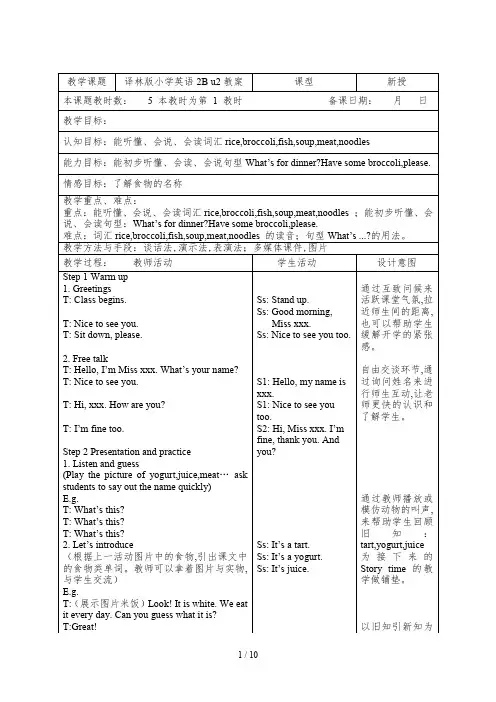
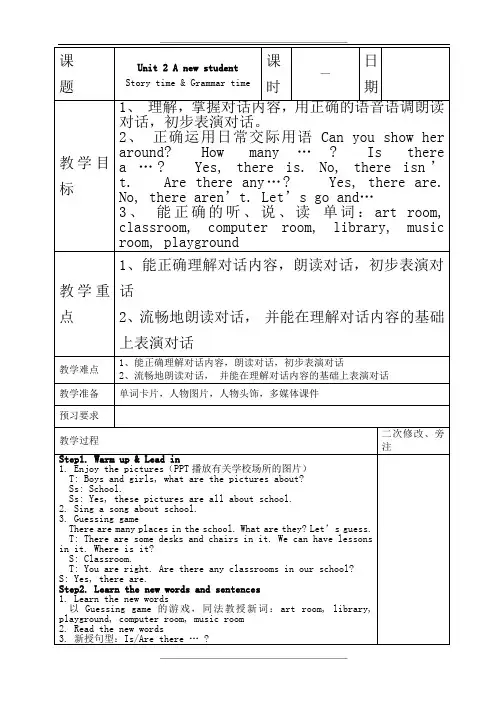
Unit 2 A new student第五课时教学内容:Unit2复习检测课教学目标:进行一些练习,让学生对于本课更加清楚,并能够熟练掌握本课单词和句型。
教学重难点:熟练运用本课单词和句型并能够在实际情境中熟练运用。
教学准备:试卷教学过程:Step 1 ReviewRead story time and cartoon time in roles.Step2 Do some exercises一、判断下列各组单词画线部分发音是否相同,用“T”或“F”表示。
()1. nice dance ()2. juice cake ()3. ice cream ()4. cinema much ()5. clock cup二、英汉互译。
1、在第一层2、three music rooms3、一名新来的学生4、how many rooms5、带我们参观6、in the playground7、太高 8、in front of our school9、去看一看 10、a new library三、用所给单词的适当形式填空。
1、 (be) there any peaches in the basket?2、There aren’t (some) swings in the park.3、Can you tell (she)the news?4、There isn’t any (bread)on the table.5、How many (library) are there in your city.6、The teachers’ office is on (one) floor.7、Let (we) go and enjoy the meal.8、This is (Mike) basketball.9、 (be) there any water in the bottle?10、There (be) two glasses of juice on the table.四、单项选择。
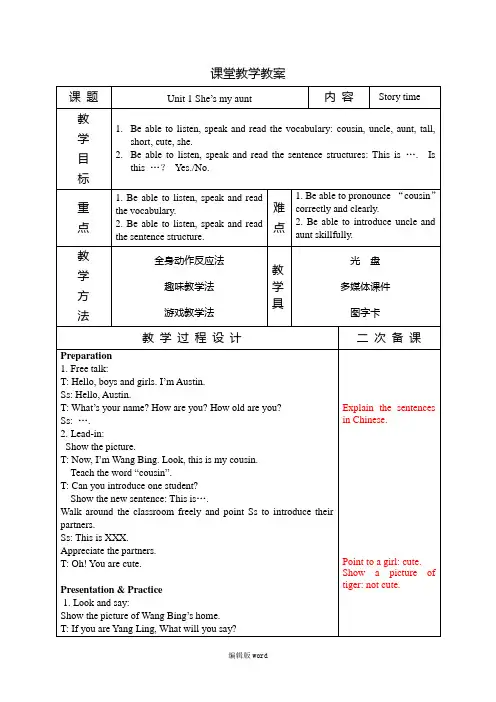
课堂教学教案课堂教学教案Explain the difference between “he” & “she”.2. Listen and stick:T introduces family members. Ss listen and help T stick word cards on the family tree.T: He’s my uncle. She’s my aunt.….3. Stick and say:Ss work in groups. Finish the family tree and introduce family members to classmates.Ss: He’s my uncle. (He is tall.) She’s my aunt.….4. Show time:Select some Ss on behalf of their groups. Come front to show their papers and introduce their family members. V ote for the best group and reward them.Production1. Play a game: Magic eyesLook, listen and answer: Who’s he/ she?Ss: He’s/ She's….2. Guess and say:Put masks on four students’ face and guess: Is this XXX?3. Summarize the class and assign homework:Listen to the cassette twice and follow it.Call the name of the family member in English.Introduce your family members to your friends. say “she”. Encourage Ss to use more sentences they have learnt to describe their family members if possible.板书设计教学反思课堂教学教案课堂教学教案课堂教学教案课堂教学教案(此文档部分内容来源于网络,如有侵权请告知删除,文档可自行编辑修改内容,供参考,感谢您的配合和支持)。
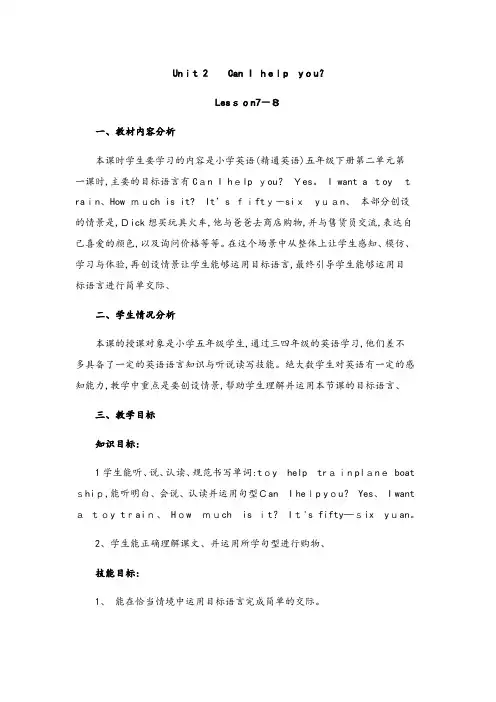
Unit 2 Can I help you?Lesson7-8一、教材内容分析本课时学生要学习的内容是小学英语(精通英语)五年级下册第二单元第一课时,主要的目标语言有Can I help you?Yes。
I want a toy train、How much is it? It’s fifty-sixyuan、本部分创设的情景是,Dick想买玩具火车,他与爸爸去商店购物,并与售货员交流,表达自己喜爱的颜色,以及询问价格等等。
在这个场景中从整体上让学生感知、模仿、学习与体验,再创设情景让学生能够运用目标语言,最终引导学生能够运用目标语言进行简单交际、二、学生情况分析本课的授课对象是小学五年级学生,通过三四年级的英语学习,他们差不多具备了一定的英语语言知识与听说读写技能。
绝大数学生对英语有一定的感知能力,教学中重点是要创设情景,帮助学生理解并运用本节课的目标语言、三、教学目标知识目标:1学生能听、说、认读、规范书写单词:toy help train plane boat ship,能听明白、会说、认读并运用句型Can I help you? Yes、 I want atoy train、 How much is it? It's fifty—six yuan。
2、学生能正确理解课文、并运用所学句型进行购物、技能目标:1、能在恰当情境中运用目标语言完成简单的交际。
2、能明白购物时的一些礼仪与礼貌用语,并能够用真实自然的语言基本完成购物。
3、能够通过同位活动或小组活动培养自主与合作学习的意识与行为、情感目标:同学之间要相互帮助,具有助人为乐的精神。
四、教学重难点教学重点:1。
学生能听、说、认读、规范书写单词:toy,help, train ,plane,boat ,ship;2、能够听、说、读句型: Can I help you? Yes、I want a toy t rain。
How much isit?It’s fifty-six yuan、教学难点:1。
译林版二年级英语教案Unit2《Wheredoyoulive》教学设计一、教学目标1.学习并掌握以下单词:home, live, city, town, village。
2.能够运用以下句型进行表达:I live in a city/town/village.3.能够听懂并能正确朗读句子:Where do you live? I live in acity/town/village.4.提高学生的听说能力,培养学生的合作意识和团队精神。
二、教学准备1.教材:译林版二年级英语教材上册 Unit 2《Where do you live?》部分。
2.教具:教学录音机,单词卡片,图片或幻灯片。
三、教学过程1. 打招呼和导入新课•老师和学生互相打招呼,营造良好的课堂氛围。
•复习上节课所学的内容,并简单提问学生:“What did we learn last time?”•引入新词汇:home、live、city、town、village。
2. 听力训练•播放录音,学生仅需听一遍。
•学生听完录音后,回答一些简单的问题,例如:“What is the title of the listening? What do you hear in the listening?”等。
3. 学习新词汇和句型•展示单词卡片或图片,教师可先出示一个单词卡片或图片,然后向学生介绍该单词的意思和发音,并要求学生重复跟读。
•教师可以通过多种互动方式,例如游戏、图片配对等,帮助学生巩固新单词的记忆。
•接下来,教师可引导学生学习句型:“I live in a city/town/village.”,并进行模仿和口头练习。
4. 句子操练•教师与学生进行对话练习,模仿句子:“Where do you live? I live in a city/town/village.”。
5. 听说训练•教师可分组让学生进行问答练习,例如A组学生向B组学生询问:“Where do you live?”,B组学生回答并补充“我住在城市/小镇/村庄。
Unit 2 A new student第五课时教学容:Unit2复习检测课教学目标:进展一些练习,让学生对于本课更加清楚,并能够熟练掌握本课单词和句型。
教学重难点:熟练运用本课单词和句型并能够在实际情境中熟练运用。
教学准备:试卷教学过程:Step 1 ReviewRead story time and cartoon time in roles.Step2 Do some exercises一、判断以下各组单词画线局部发音是否一样,用“T〞或“F〞表示。
〔〕1. nice dance 〔〕2. juice cake 〔〕3. ice cream 〔〕4. cinema much 〔〕5. clock cup二、英汉互译。
1、在第一层2、three music rooms3、一名新来的学生4、how many rooms5、带我们参观6、in the playground7、太高8、in front of our school9、去看一看10、a new library三、用所给单词的适当形式填空。
1、(be) there any peaches in the basket?2、There aren’t (some) swings in the park.3、Can you tell 〔she〕the news"4、There isn’t any〔bread〕on the table.5、How many(library) are there in your city.6、The teachers’office is on(one) floor.7、Let (we) go and enjoy the meal.8、This is(Mike) basketball.9、(be) there any water in the bottle"10、There(be) two glasses of juice on the table.四、单项选择。
译林版小学英语二年级上册教案Unit 2 I have a rabbit ( Period 1)教学目标:1、Be able to listen, speak and read the vocabulary: rabbit, dog, hamster, cat, big, small.2、Be able to listen, speak and read the sentence structure: I have a …. It’s …. It’s ….教学重点:1. Be able to listen, speak and read the vocabulary.2. Be able to listen, speak and read the sentence structure.教学难点:1. Be able to pronounce “hamster” and “rabbit” correctly and clearly.2. Be able to distinguish the characteristics of three animals.教学过程:Preparation1. Free talk:T: Hello. How are you?/ Is this …?/ …Ss: ….2. Enjoy a song:Sing the song This is my uncle.3. Lead-in:Play a game: Magic earsListen and guess the name of animals.Moo! Moo! cowWoof! Woof! dogSqueak! Squeak! hamsterMiaow! Miaow! catQuack! Quack! duckTeach the word “dog” “cat” and “hamster” .1. Look and say:Show the pictures.T: I have a hamster. It’s small.T: I have a dog. It’s big.Teach the new sentence “I have a …. It’s ….”Show more pictures. Lead Ss to practice and make more sentences. Ss: I have a …. It’s ….2.Watch and complete the table:A Liu Tao.B rabbit.C small.D brown.Teach the word “rabbit” .3. Listen and repeat.4. Read together5. Happy readingSs work in groups and choose one way to read the dialogue: Read after one person/ Read together/ Read in roles5.Act the dialogues in roles.Production1.Play a game: Little detectiveSs help to find the missing animals according to the description. 2. Summarize the class and assign homework:Listen to the cassette twice and follow it.Talk about your pets with your classmates.Step 5 Assign homework1. 听录音,读熟P6页。
译林版二年级英语教案Unit 2 《Where do you live》教学过程Step1.Wordphrase1.学习live老师指出,live表示居住之意,并举出例句IliveinShanghai.表示住在上海。
师生用where和live进行对话。
T:Wheredoyoulive?S:IliveinShanghai.老师强调live是不及物动词,不能说IliveShanghai.2.学习moon老师展示月亮的图片,引入单词moon。
T:Whatisit?S:Itsthemoon.3.学习sky老师展示蓝天的图片,引入sky。
老师指出sky之前用in这个介词。
T:Wheredoesthemoonlive?S:Itlivesinthesky.4.学习city老师展示城市的图片,引入city。
老师指出city之前用in这个介词。
T:Wheredowelive?S:Weliveinthecity.Step2.Letslearn1.学习活动1请几名同学分别扮演boy、moon和旁白进行对话。
2.看图说话老师展示已经去掉文字的活动6的图,请学生根据场景进行对话。
3.分角色朗读请几组同学利用这两节课学习的句型,到讲台上进行分角色对话。
Step3.Letsread1.请学生默读课文,回答老师给出的问题。
Q:Wheredoesshelive?A:ShelivesinBeijing.Q:Isitabigcity? 2.播放录音,请学生跟读活动2。
请几位学生说出自己的答案,老师对答案进行核对。
3.请几位学生进行范读,老师纠正朗读过程中的错误。
4.请学生根据自己的情况给Tingting写回信,请几位同学读出自己的回信。
Step4.Learnletters1.学习韵文学习活动4韵文,引入字母L、N和M。
学生一齐唱韵文,加深印象。
2.学习例词老师通过图片教授单词lion、monkey和nose,通过韵文让学生扩展词汇3.学习书写播放字母书写的动画,让学生观察笔顺。
译林版二年级英语教案Unit2《Wheredoyoulive》教学过程教学目标1.能正确地听、说、读、写并运用以下单词:city, village, town。
2.能够熟练地运用句型“I live in a/an + 地点名词”表达自己的居住地。
3.能够通过听力材料理解并回答与居住地相关的问题。
教学准备1.教材:译林版二年级上册英语教材2.教具:单词卡片、图片、投影仪教学过程Step 1: 导入新课 (5分钟)1.向学生们问候并询问他们的居住地,引入新课。
2.出示单词“city”,并解释其意思,让学生们尝试朗读该单词。
Step 2: 单词讲解 (10分钟)1.展示单词卡片“city” 并跟随朗读,帮助学生们记住该单词。
2.分组操练:将学生分成小组,每组派出一名代表站在教室不同的地点并说出:“I live in a city”,其他组员尝试回答代表所在的地点是哪里。
Step 3: 新课呈现 (15分钟)1.展示图片或投影“village”一词,并解释其意思,让学生朗读并模仿。
2.通过问题引导学生思考:“Where do you live? Do you live in a city o r in a village?”,并与学生进行对话练习,引导他们用所学的句型回答。
Step 4: 单词讲解 (10分钟)1.展示单词卡片“village” 并跟随朗读,帮助学生们记住该单词。
2.分组操练:将学生分成小组,每组派出一名代表站在教室不同的地点并说出:“I live in a village”,其他组员尝试回答代表所在的地点是哪里。
Step 5: 新课呈现 (15分钟)1.展示图片或投影“town” 一词,并解释其意思,让学生朗读并模仿。
2.通过问题引导学生思考:“Where do you live? Do you live in a city, a village or in a town?”,并与学生进行对话练习,引导他们用所学的句型回答。
译林版二年级英语教案Unit2《He doesn’t like these trousers》教学过程教学目标•知识目标:通过本节课的学习,学生将掌握单词t-shirt, trousers等的读音和拼写,能够正确理解和使用这些单词。
•能力目标:能够用英语表达对不同衣物的喜好和不喜欢,并能够描述人物的着装。
•情感目标:培养学生对于英语学习的兴趣,鼓励学生自主学习和积极参与课堂活动。
教学重点和难点•教学重点:使学生学会用英语表达对不同衣物的喜好和不喜欢,掌握单词t-shirt, trousers等的读音和拼写。
•教学难点:让学生能够自主组织语言,用英语描述人物的着装情况。
教学准备•教材:《译林版二年级英语上册》Unit 2•教具:黑板、彩色粉笔、课件、单词卡片教学过程Step 1 导入新知1.教师准备一个装有不同衣物图片的课件,并呈现给学生,帮助学生复习之前学过的单词,如:t-shirt, trousers等。
2.老师出示一张图片,让学生说出图片上人物穿的是什么衣服,并用句子描述。
Step 2 新课呈现1.教师出示一张图片,图片上有一个男孩。
教师问学生:What’s hisname? (他叫什么名字?)2.学生回答:His name is Tim. (他叫Tim。
)3.教师继续问学生:What’s he wearing? (他穿着什么?)4.学生回答:He is wearing a t-shirt. (他穿着一件T恤。
)5.教师板书:Tim is wearing a t-shirt. (Tim穿着一件T恤。
)6.教师重复以上步骤,让学生熟悉和理解这个句型。
Step 3 对话练习1.教师出示一些不同人物穿着不同衣物的图片,并组织学生进行对话练习。
例如:–Teacher: Look at the picture. What’s he/she wearing?–Students: He/She is wearing a _______.–Teacher: Do you like his/her ______?–Students: Yes, I do. / No, I don’t.2.教师指导学生根据实际情境进行对话练习,让学生能够自由组织语言。